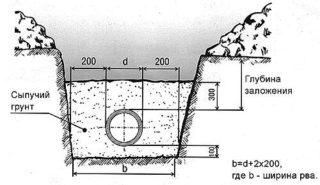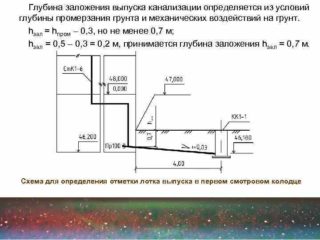The arrangement of a private house is, first of all, the installation of communications: power supply, water supply, sewerage. Life in the cottage will not be comfortable enough without them. When constructing a collector, it is important to correctly calculate at what depth to bury the sewer pipe in a private house (the outer part of the communication). The operability of the system as a whole at any time of the year depends on the correctness of the selected parameter.
Why is sewer depth important?
- A correctly laid line does not lend itself to the negative effects of subzero temperatures. Frost does not form in pipes mounted below the freezing level of the soil, therefore the collector functions normally, without plugs, freezing.
- Optimally selected depth provides easy access to the line in case of repair work if the collector leaks.
- It is worth considering the static / dynamic loads on the pipes. If the collector is laid under an area with high loads (parking for cars, traffic in the yard), you need to place it a little deeper. This will protect the tubes from subsequent deformation.
The septic tank is buried so that only its upper hatch protrudes above the ground. If there is a need to deepen the chamber more, the outlet will have to be artificially extended upwards.
Requirements for the depth of laying the sewer in a private house
In addition, SNiP 2.01.01.82 brings to the attention of specialists a special map-table. It contains the recommended values for the depth of the reservoir, depending on the region of the country. In the northern parts of Russia, the desired level of laying pipes in the soil is from 1.4 m.In the southern regions of the country, the value of 0.8 m can be adhered to.
It is important to pay attention to the height of the pipe outlet from the house. SNiP regulates the indicator of 30 cm or more from the average level of the sewerage line in the region. If the calculated optimal collector depth is 80 cm, then the outlet is mounted at a height of 1.1 m.
Additionally, SNiP establishes approximate rates of reservoir occurrence, depending on the cross-section of the pipes (for the southern regions). With a line diameter of 500 mm, it is laid to a depth of 50 cm or more. If the tube has a cross-section of up to 500 mm, you can deepen the collector at a small mark of 30-50 cm.If dynamic pressure is applied to the pipeline, the pipeline is already laid at a minimum mark of 90 cm.
If the collector is laid too deeply, you may encounter a number of such problems:
- Labor cost of work: digging trenches / foundation pit, attracting special equipment, etc. This is reflected in the cost.
- Risk of fatigue cracks forming on pipes. They arise under the pressure of heaving soil and groundwater.
- Complex maintenance of the system: flushing, possible need for repair.
In some cases, SNiP still recommends putting the sewer system deeper.With a high level of groundwater or the presence of rocks in the section, pipes are mounted at a level of 3-4 m from the surface of the earth. On dry, non-porous soils, you can lay the highway at a maximum mark of 5-8 meters.
When installing the manifold, it is advisable to avoid sharp corners and turns. If it is impossible to refuse them, I install inspection hatches in the "difficult" places of the pipeline.
Factors affecting the level of pipe laying

When drawing up project documentation for the sewer system, a number of factors must be taken into account that affect the final depth indicator:
- features of the site's relief: the presence of sharp changes in height from the house to the end point of the sink of the drains;
- type of soil: swampy, heaving, rocky, clayey, sandy;
- climatic indicators in the region: taken from the table of sanitary norms and rules;
- type of sewerage system: pressure, free-flow;
- method of pipeline installation: with or without trays.
It should be borne in mind that the wastewater flowing through the pipes has an average temperature of 14-16 degrees. They can warm the collector from the inside. But the longer the line, the more likely it is that dirty water will cool down to sub-zero temperatures already in the middle of the pipeline. Therefore, relying on relatively warm drains is risky. The chance that this will actually work is extremely small.
Calculation of the depth of the drainage system
To carry out accurate calculations and determine the final mark on which the pipeline can be buried, it is necessary to take into account several parameters at once:
- the recommended sewerage depth in the region;
- the height of the septic tank, including from concrete rings or even car tires;
- the length of the highway from the exit from the house to the receiver;
- collector slope.
For example, let's take the middle zone of Russia, for which the recommended depth of the collector laying varies between 80-120 cm. At the same time, we have a septic tank height of 1.5 m. The total length of the highway is 15 meters. Here we take into account that the recommended slope for free-flow sewage is 0.8-1 cm for each running meter (for pipes with a cross section of 220 mm). From the point of exit from the house to the septic tank, the collector will deepen by 15 cm.This means that a trench is dug at a depth of 80 cm from the exit from the cottage and the end point of the canal is made already at around 95 cm.
If, due to the peculiarities of the relief, it is impossible to comply with the recommended depth in one of the sections of the length of the collector, this part of the pipes should be thoroughly insulated. When laying pipes, they must be securely fixed so that over time they do not move under static or dynamic loads.
The ditch for the sewer line is always dug 15-20 cm deeper. This place will be taken in the future by a sand cushion-base under the highway.
Reservoir depth reduction options
- High-quality pipe insulation. To do this, you can use a heating electric cable (it is wound outside the tubes), expanded clay sprinkling of the main line or fiberglass insulation. They are put on tubes as a casing.
- Using a special fecal-drainage pump that will drive wastewater through pipes from the house under pressure. As a result of the increased speed of the sewage media, plugs will not form in the system.
- Artificial increase in the soil layer over the stacked tubes. We'll have to make a kind of embankment over the system. It can be decorated with elegant landscape design solutions (hills, high lawns). However, it is impossible to plant complex powerful plants with a large root system on them. Only flowers or lawn grass.
- Use of pipes with thick walls. Most often it is cast iron or steel. But they are also expensive and require a lot of labor when constructing a collector.If plastic elements are taken, it is advisable to lay them in a special protective corrugation.
Each master must carefully weigh the capabilities of the site in order to properly lay the sewer line at an acceptable minimum depth. Only in this case the system will function smoothly. The same goes for a closed type storm drainage system.











